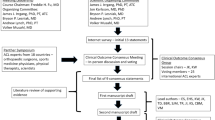Abstract
Purpose
The use of patient reported outcome measures has gained increasing prominence in reporting surgical outcomes following primary anterior cruciate ligament reconstruction (ACLR). Many peer-reviewed journals now require ‘end-result’ outcomes in excess of 24 months following surgery for publication. As such, there is less focus on early recovery when the greatest rate of change is experienced and when key rehabilitation decisions are made relating to restricted activity and return to sports. We sought to examine the early recovery profile of patients following primary ACLR, determine the presence of any plateau effect of recovery and establish a source of reference for future study.
Method
One hundred and sixty-five patients undergoing primary ACLR were identified from a prospective database. The Knee Injury and Osteoarthritis Outcome Score (KOOS) was recorded pre-operatively and at the 3-, 6- and 12-month follow-up reviews. Mean scores were developed to plot a standard ‘recovery profile’ of statistical analysis for the presence of any plateau effect.
Results
There were significant improvements in all mean KOOS domains at 12 months following ACLR (P < 0.001) and between each recording point (P < 0.003), discounting any plateau effect. Rates of graft rupture and other surgical complications were low (1.2 and 1.8 %). The recovery profile of mean KOOS scores illustrated a reduced rate of recovery over time with sports/recreation and knee-related quality of life KOOS domains demonstrating the greatest sensitivity to change.
Conclusions
This study profiles the early recovery of patients following primary ACLR using the KOOS demonstrating continued recovery of function throughout the full first 12 months with no evidence of a plateau effect. The early results in ACLR have not previously been reported in a study of this size and provide important data upon which key rehabilitation decisions can be based.
Level of evidence
Therapeutic study–case series with no comparison group, Level IV.





Similar content being viewed by others
References
Ageberg E, Forssblad M, Herbertsson P, Roos EM (2010) Sex differences in patient-reported outcomes after anterior cruciate ligament reconstruction: data from the Swedish knee ligament register. Am J Sports Med 38(7):1334–1342
Browne J, Jamieson L, Lewsey J, van der Meulen J et al (2007) Patient reported outcome measures (PROMs) in elective surgery. Report to the Department of Health. Health Services Research Unit, London School of Hygiene & Tropical Medicine and Clinical Effectiveness Unit, Royal College of Surgeons of England, UK
de Groot IB, Favejee MM, Reijman M, Verhaar JA, Terwee CB (2008) The Dutch version of the Knee Injury and Osteoarthritis Outcome Score: a validation study. Health Qual Life Outcomes 26:6–16
Department of Health (2008) Guidance on the routine collection of patient reported outcome measures (PROMs). TSO, London
Department of Health (2009) High quality care for all. NHS Next Stage Review. Final Report. TSO, London
Granan L, Bahr R, Steindal K, Furnes O, Engebretsen L (2008) Development of a National Cruciate Ligament Surgery Registry. The Norwegian National Knee Ligament Registry. Am J Sports Med 36:308–315
Granan L-P, Forssblad M, Lind M, Engebretsen L (2009) The Scandinavian ACL registries 2004–2007: baseline epidemiology. Acta Orthop 80(5):563–567
Hanna AW (2004) The knee. In: Pynsent P, Fairbank J, Carr A (eds) Outcome measures in orthopaedics and orthopaedic trauma, 2nd edn. Hodder Arnold Publishers, London
Lind M, Menhert F, Pedersen AB (2009) The first results from the Danish ACL reconstruction registry: epidemiologic and 2 year follow-up results from 5,818 knee ligament reconstructions. Knee Surg Sports Traumatol Arthrosc 17(2):117–124
Magnussen RA, Granan L-P, Dunn WR et al (2010) Cross-cultural comparison of patients undergoing ACL reconstruction in the United States and Norway. Knee Surg Sports Traumatol Arthrosc 18:98–105
Marx RG, Jones EC, Allen AA, Altchchek DW, O’Brien SJ, Rodeo SA, Williams RJ, Warren RF, Wickiewicz TL (2001) Reliability, validity, and responsiveness of four knee outcome scales for athletic patients. J Bone Joint Surg Am 83:1459–1469
Roos EM, Roos HP, Ekdahl C, Lohmander LS (1998) Knee Injury and Osteoarthritis Outcome Score (KOOS)—validation of a Swedish version. Scand J Med Sci Sports 8(6):439–448
Roos EM, Roos HP, Lohmander LS, Ekdahl C, Beynnon BD (1998) Knee Injury and Osteoarthritis Outcome Score (KOOS)—development of a self-administered outcome measure. J Orthop Sports Phys Ther 28(2):88–96
Smith CK, Howell SM, Hull ML (2011) Anterior laxity, slippage, and recovery of function in the first year after tibialis allograft anterior cruciate ligament reconstruction. Am J Sports Med 39(1):78–88
Tanner SM, Dainty KN, Marx RG, Kirkley A (2007) Knee-specific quality-of-life instruments: which ones measure symptoms and disabilities most important to patients? Am J Sports Med 35(9):1450–1458
Wright RW, Dunn WR, Amendola A et al (2007) Risk of tearing the intact anterior cruciate ligament in the contralateral knee and rupturing the anterior cruciate ligament graft during the first 2 years after anterior cruciate ligament reconstruction. A prospective MOON cohort study. Am J Sports Med 35(7):1131–1334
Zaffagnini S, De Pasquale V, Reggiani LM, Russo A et al (2010) Electron microscopy of the remodelling process in hamstring tendon used as ACL graft. Knee Surg Sports Traumatol Arthrosc 18:1052–1058
Acknowledgments
The authors would like to thank Joanne Zamani and Stephanie Hughes (Department of Research and Development, Frimley Park Hospital NHS Foundation Trust, Camberley, Surrey, GU16 7UJ, UK) for their advice and assistance in the preparation and statistical analysis of the results.
Conflict of interest
The authors declare that they have no conflict of interest.
Ethical standards
This study was conducted in accordance with the standards required by the Research Ethics Committee at Royal Berkshire Hospital NHS Foundation Trust. Informed consent was obtained from all patients prior to their inclusion in the study.
Author information
Authors and Affiliations
Corresponding author
Rights and permissions
About this article
Cite this article
Hill, G.N., O’Leary, S.T. Anterior cruciate ligament reconstruction: the short-term recovery using the Knee Injury and Osteoarthritis Outcome Score (KOOS). Knee Surg Sports Traumatol Arthrosc 21, 1889–1894 (2013). https://doi.org/10.1007/s00167-012-2225-x
Received:
Accepted:
Published:
Issue Date:
DOI: https://doi.org/10.1007/s00167-012-2225-x




